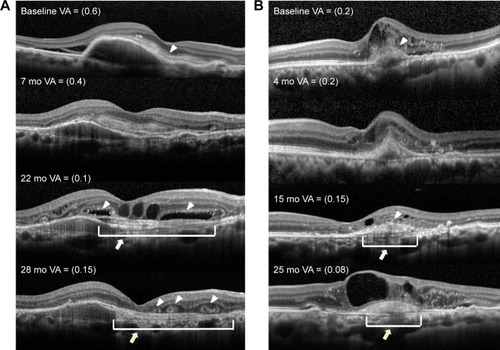Figures & data
Table 1 Patient characteristics according to the type of choroidal neovasculopathy
Figure 1 Incidence of ORT.
Abbreviations: ORT, outer retinal tubulation; CNV, choroidal neovascularization; t-AMD, typical age-related macular degeneration; PCV, polypoidal choroidal vasculopathy; RAP, retinal angiomatous proliferation; mCNV, myopic choroidal neovascularization.

Figure 2 Pathological changes in optical coherence tomography findings that precede the formation of subretinal hyperreflective material and ORT.
Abbreviations: ORT, outer retinal tubulation; PCV, polypoidal choroidal vasculopathy; SHRM, subretinal hyperreflective material; t-AMD, typical age-related macular degeneration; CNV, choroidal neovascularization; RPE, retinal pigment epithelium; VA, visual acuity; Mo, months; ISe, inner segment ellipsoid.

Figure 3 Incidence of subretinal fibrosis.
Abbreviations: CNV, choroidal neovascularization; t-AMD, typical age-related macular degeneration; PCV, polypoidal choroidal vasculopathy; RAP, retinal angiomatous proliferation; mCNV, myopic choroidal neovascularization; CNV, choroidal neovascularization.

Table 2 Results of univariate analysis between the ORT(+) and ORT(−) groups
